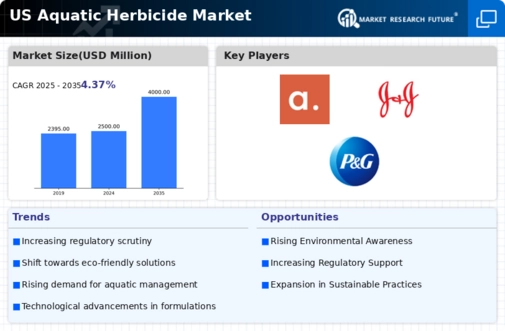Rising Recreational Water Use
The growing popularity of recreational activities in water bodies is significantly impacting the aquatic herbicide market. As more individuals engage in boating, fishing, and swimming, the demand for clean and safe water environments increases. This trend necessitates the effective management of aquatic weeds that can hinder recreational use. The market is expected to grow at a CAGR of around 5% over the next few years, as stakeholders invest in herbicides to ensure optimal conditions for recreational activities. Local governments and private entities are increasingly recognizing the importance of maintaining clear waterways, which in turn drives the demand for effective aquatic herbicides. The aquatic herbicide market was thus positioned to benefit from this rising trend, as it aligned with the need for enhanced water quality and user experience.
Increasing Water Quality Regulations
The aquatic herbicide market is experiencing growth due to the increasing stringency of water quality regulations in the US. Regulatory bodies are emphasizing the need for effective management of aquatic vegetation to maintain water quality in lakes, rivers, and reservoirs. This has led to a heightened demand for herbicides that can control invasive species while adhering to environmental standards. The market was projected to reach approximately $1.5 billion by 2026, driven by the need for compliance with these regulations. As municipalities and water management authorities seek solutions to prevent algal blooms and maintain ecosystem balance, The aquatic herbicide market was likely to see a surge in product development and application. This regulatory landscape creates opportunities for manufacturers to innovate and offer products that align with environmental sustainability goals.
Growing Awareness of Invasive Species
The rising awareness of the impact of invasive aquatic species is driving the aquatic herbicide market. Invasive species can disrupt local ecosystems, leading to significant ecological and economic consequences. As stakeholders, including government agencies and environmental organizations, recognize the need for effective management strategies, the demand for aquatic herbicides is expected to rise. Educational campaigns and research initiatives are highlighting the importance of controlling these species to protect native biodiversity. The market is projected to expand as more resources are allocated to combat invasive species, with herbicides being a key tool in these efforts. This growing awareness is likely to foster collaboration between various sectors, further enhancing the aquatic herbicide market's growth potential.
Advancements in Formulation Technologies
Innovations in formulation technologies are playing a crucial role in shaping the aquatic herbicide market. The development of more effective and environmentally friendly formulations is becoming a priority for manufacturers. These advancements allow for targeted application, reducing the impact on non-target species and improving overall efficacy. For instance, the introduction of slow-release formulations and biodegradable options is gaining traction among consumers and regulatory bodies alike. This shift not only enhances the effectiveness of herbicides but also aligns with the growing demand for sustainable practices in agriculture and water management. As a result, the aquatic herbicide market is likely to see increased investment in research and development, leading to a broader range of products that meet both consumer needs and regulatory requirements.
Increased Investment in Water Management Infrastructure
Investment in water management infrastructure is a significant driver for the aquatic herbicide market. As municipalities and private entities allocate funds to improve water quality and manage aquatic ecosystems, the demand for effective herbicides is likely to increase. Infrastructure projects aimed at enhancing water treatment facilities and maintaining water bodies create a need for reliable herbicide solutions. The market was expected to benefit from these investments, as they often included provisions for controlling aquatic vegetation. Furthermore, the integration of herbicide application into broader water management strategies indicates a growing recognition of the importance of maintaining healthy aquatic environments. This trend suggests a promising outlook for the aquatic herbicide market as it aligns with the ongoing efforts to enhance water quality and ecosystem health.

















Leave a Comment